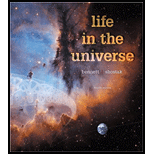
Life in the Universe - With Activity Manual and Access
4th Edition
ISBN: 9780134575599
Author: Bennett
Publisher: PEARSON
expand_more
expand_more
format_list_bulleted
Concept explainers
Textbook Question
Chapter 4, Problem 41POS
The Age of Earth. Some people still question whether we have a reasonable knowledge of the age of Earth or the ability to date events in Earth’s history. Based on what you have learned about both relative and absolute ages on the geological time scale, do you think it is reasonable for scientists to be confident of ages found by radiometric dating? Is there any scientific reason to doubt the reliability of our chronology of Earth? Explain.
Expert Solution & Answer
Want to see the full answer?
Check out a sample textbook solution
Students have asked these similar questions
We think the terrestrial planets formed around solid “seeds” that later grew over time through the accretion of rocks and metals.
a) Suppose the Earth grew to its present size in 1 million years through the accretion of particles averaging 100 grams each. On average, how many particles did the Earth capture per second, given that the mass of the Earth is = 5.972 × 10 ^24 kg ?
b) If you stood on Earth during its formation and watched a region covering 100 m^2, how many impacts would you expect to see in one hour. Use the impact rate you calculated in part a. You’ll need the following as well: the radius of the Earth is = 6.371 × 10 ^6 m and the surface area of the Earth is 4??^2Earth
How is a habitable zone likely to change over time?
a. get narrower
b. move further from the star
c. they aren't likely to change
Activity #1. Compare and Contrast. Similarities and differences of Venus, Earth and Mars.
Do this on a separate sheet of paper.
1. Compare and contrast the three (3) terrestrial planets using table 1.
2. Provide explanations for your observations using table 2.
3. Answer the following guide questions.
Guide questions:
1. Does planet size affect gravity?
2. Why do you think Venus has the highest mean temperature among the three planets?
3. Is presence of water a primary factor for a planet to sustain life? Why or why not?
4. Based on your observations using table 2, what are the notable features that makes the
earth the only habitable planet among the three terrestrial planets?
5. What conclusions can you make?
Additional Science Textbook Solutions
Find more solutions based on key concepts
26.9 Relativistic Energy
33. Determine the ratio of an electron's total energy to rest energy when moving at th...
College Physics
24. The 1.0 kg block in FIGURE EX7.24 is tied to the wall with a rope. It sits on top of the 2.0 kg block. The ...
Physics for Scientists and Engineers: A Strategic Approach, Vol. 1 (Chs 1-21) (4th Edition)
33.43 A glass plate 2.50 mm thick, with an index of refraction of 1.40, is placed between a point source of lig...
University Physics (14th Edition)
28. A beating heart. How many times does a human heart beat during a lifetime? How many gallons of blood does i...
College Physics (10th Edition)
The filament of a 100-W lightbulb is at 3.0 kK. Whats the filaments surface area?
Essential University Physics: Volume 1 (3rd Edition)
Knowledge Booster
Learn more about
Need a deep-dive on the concept behind this application? Look no further. Learn more about this topic, physics and related others by exploring similar questions and additional content below.Similar questions
- We believe that Venus, Earth, and Mars all started with a significant supply of water. Explain where that water is now for each planet.arrow_forwardDescribe how we use radioactive elements and their decay products to find the age of a rock sample. Is this necessarily the age of the entire world from which the sample comes? Explain.arrow_forwardIf you represent Earths history by a line that is 1 m long, how long a segment would represent the 400 million years since life first moved onto the land? How long a segment would represent the 4-millionyear history of humanoid life?arrow_forward
- Detail some of the anthropogenic changes to Earth’s climate and their potential impact on life.arrow_forwardWhy is there so little evidence of Earth’s earliest history and therefore the period when life first began on our planet?arrow_forwardDescribe the current atmosphere on Mars. What evidence suggests that it must have been different in the past?arrow_forward
- Name three locations in our Solar System to search for Earth-like life and explain your choices.arrow_forwardWhat does a planet need in order to retain an atmosphere? How does an atmosphere affect the surface of a planet and the ability of life to exist?arrow_forwardIn what ways is Earth unique among the Terrestrial planets?arrow_forward
arrow_back_ios
SEE MORE QUESTIONS
arrow_forward_ios
Recommended textbooks for you

 Stars and Galaxies (MindTap Course List)PhysicsISBN:9781337399944Author:Michael A. SeedsPublisher:Cengage Learning
Stars and Galaxies (MindTap Course List)PhysicsISBN:9781337399944Author:Michael A. SeedsPublisher:Cengage Learning Foundations of Astronomy (MindTap Course List)PhysicsISBN:9781337399920Author:Michael A. Seeds, Dana BackmanPublisher:Cengage Learning
Foundations of Astronomy (MindTap Course List)PhysicsISBN:9781337399920Author:Michael A. Seeds, Dana BackmanPublisher:Cengage Learning University Physics Volume 1PhysicsISBN:9781938168277Author:William Moebs, Samuel J. Ling, Jeff SannyPublisher:OpenStax - Rice University
University Physics Volume 1PhysicsISBN:9781938168277Author:William Moebs, Samuel J. Ling, Jeff SannyPublisher:OpenStax - Rice University Horizons: Exploring the Universe (MindTap Course ...PhysicsISBN:9781305960961Author:Michael A. Seeds, Dana BackmanPublisher:Cengage Learning
Horizons: Exploring the Universe (MindTap Course ...PhysicsISBN:9781305960961Author:Michael A. Seeds, Dana BackmanPublisher:Cengage Learning AstronomyPhysicsISBN:9781938168284Author:Andrew Fraknoi; David Morrison; Sidney C. WolffPublisher:OpenStax
AstronomyPhysicsISBN:9781938168284Author:Andrew Fraknoi; David Morrison; Sidney C. WolffPublisher:OpenStax


Stars and Galaxies (MindTap Course List)
Physics
ISBN:9781337399944
Author:Michael A. Seeds
Publisher:Cengage Learning

Foundations of Astronomy (MindTap Course List)
Physics
ISBN:9781337399920
Author:Michael A. Seeds, Dana Backman
Publisher:Cengage Learning

University Physics Volume 1
Physics
ISBN:9781938168277
Author:William Moebs, Samuel J. Ling, Jeff Sanny
Publisher:OpenStax - Rice University

Horizons: Exploring the Universe (MindTap Course ...
Physics
ISBN:9781305960961
Author:Michael A. Seeds, Dana Backman
Publisher:Cengage Learning

Astronomy
Physics
ISBN:9781938168284
Author:Andrew Fraknoi; David Morrison; Sidney C. Wolff
Publisher:OpenStax
General Relativity: The Curvature of Spacetime; Author: Professor Dave Explains;https://www.youtube.com/watch?v=R7V3koyL7Mc;License: Standard YouTube License, CC-BY